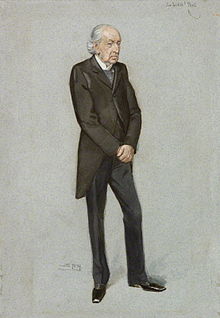Sir Frederick Peel KCMG PC (26 October 1823 – 6 June 1906) was a British Liberal Party politician and railway commissioner.
Sir Frederick Peel | |
|---|---|
 "a Railway Commissioner". Caricature by "Spy" (Leslie Ward) published in Vanity Fair in 1903. | |
| Financial Secretary to the Treasury | |
| In office 2 November 1860 – 19 August 1865 | |
| Monarch | Victoria |
| Prime Minister | The Viscount Palmerston |
| Preceded by | Samuel Laing |
| Succeeded by | Hugh Childers |
| Personal details | |
| Born | 26 October 1823 |
| Died | 6 June 1906 (aged 82) |
| Nationality | British |
| Political party | Liberal |
| Parents | |
| Alma mater | Trinity College, Cambridge |
Background and education
editPeel was second son of Sir Robert Peel, Prime Minister of the United Kingdom, and his wife Julia, daughter of General Sir John Floyd, 1st Baronet. He was the brother of Sir Robert Peel, 3rd Baronet, Sir William Peel and Arthur Peel, 1st Viscount Peel.[1] He was educated at Harrow and Trinity College, Cambridge, becoming a barrister in 1849.[2] At Cambridge he was a member of the Pitt Club.[3]
Political career
editPeel entered parliament in that year, when he was elected at an unopposed by-election in February 1849 as a Member of Parliament (MP) for Leominster.[4] At the next general election, in 1852, he was returned as the MP for Bury,[5] but was defeated in 1857.[5] He regained the Bury seat in 1859, and remained in the House of Commons until a further defeat in 1865.[5] He served as Under-Secretary of State for War and the Colonies under Lord John Russell from 1851 to 1852 and under Lord Aberdeen from 1852 to 1854, as Under-Secretary of State for the Colonies under Aberdeen from 1854 to 1855 and as Under-Secretary of State for War under Lord Palmerston from 1855 to 1857, when he was sworn of the Privy Counsellor.[6] He again held office under Palmerston and then Russell as Financial Secretary to the Treasury from 1860 to 1865.[7]
Peel's chief service to the state was in connection with the Railway and Canal Commission. He was appointed a commissioner on the inception of this body in 1873, and was its president until its reconstruction in 1888, remaining a member of the commission until his death in 1906.[7] He was appointed a Knight Commander of the Order of St Michael and St George in 1869.[8]
Death
editPeel died in June 1906, aged 82.
See also
editReferences
edit- ^ "Person Page". www.thepeerage.com. Retrieved 8 September 2022.
- ^ "Peel, Frederick (PL841F)". A Cambridge Alumni Database. University of Cambridge.
- ^ Fletcher, Walter Morley (2011) [1935]. The University Pitt Club: 1835–1935 (First paperback ed.). Cambridge: Cambridge University Press. p. 26. ISBN 978-1-107-60006-5.
- ^ Craig, F. W. S. (1989) [1977]. British parliamentary election results 1832–1885 (2nd ed.). Chichester: Parliamentary Research Services. p. 181. ISBN 0-900178-26-4.
- ^ a b c Craig, p. 72.
- ^ "No. 21998". The London Gazette. 8 May 1857. p. 1616.
- ^ a b One or more of the preceding sentences incorporates text from a publication now in the public domain: Chisholm, Hugh, ed. (1911). "Peel, Sir Robert s.v. Sir Frederick Peel". Encyclopædia Britannica. Vol. 21 (11th ed.). Cambridge University Press. p. 44.
- ^ "No. 23512". The London Gazette. 1 July 1869. p. 3750.